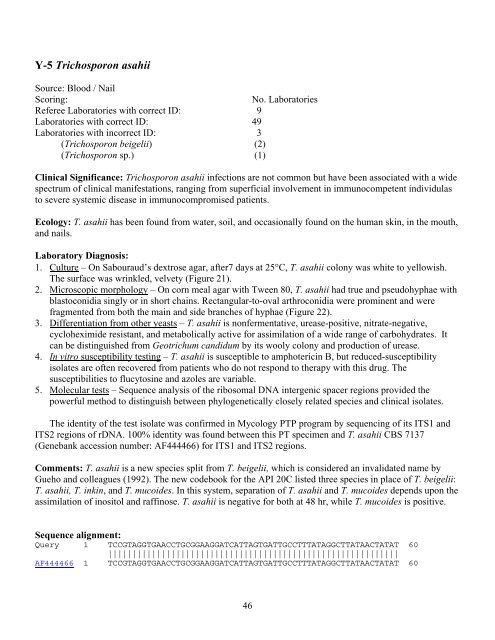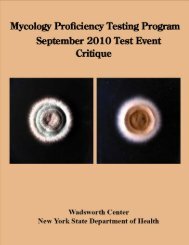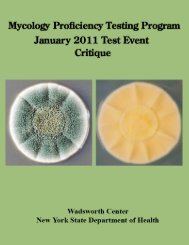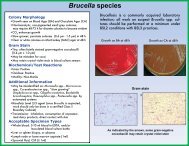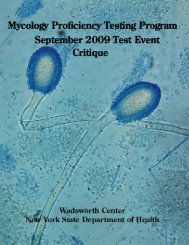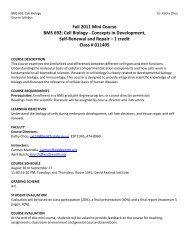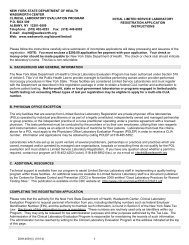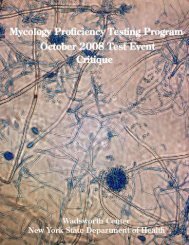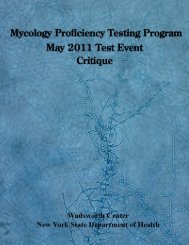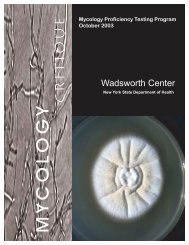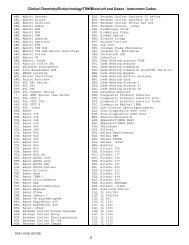Y-5 Trichosporon asahiiSource: Blood / NailScoring:No. LaboratoriesReferee Laboratories with correct ID: 9Laboratories with correct ID: 49Laboratories with incorrect ID: 3(Trichosporon beigelii) (2)(Trichosporon sp.) (1)Clinical Significance: Trichosporon asahii infections are not common but have been associated with a widespectrum of clinical manifestations, ranging from superficial involvement in immunocompetent individulasto severe systemic disease in immunocompromised patients.Ecology: T. asahii has been found from water, soil, and occasionally found on the human skin, in the mouth,and nails.Laboratory Diagnosis:1. Culture – On Sabouraud’s dextrose agar, after7 days at 25°C, T. asahii colony was white to yellowish.The surface was wrinkled, velvety (Figure 21).2. Microscopic morphology – On corn meal agar with Tween 80, T. asahii had true and pseudohyphae withblastoconidia singly or in short chains. Rectangular-to-oval arthroconidia were prominent and werefragmented from both the main and side branches of hyphae (Figure 22).3. Differentiation from other yeasts – T. asahii is nonfermentative, urease-positive, nitrate-negative,cycloheximide resistant, and metabolically active for assimilation of a wide range of carbohydrates. Itcan be distinguished from Geotrichum candidum by its wooly colony and production of urease.4. In vitro susceptibility testing – T. asahii is susceptible to amphotericin B, but reduced-susceptibilityisolates are often recovered from patients who do not respond to therapy with this drug. Thesusceptibilities to flucytosine and azoles are variable.5. Molecular tests – Sequence analysis of the ribosomal DNA intergenic spacer regions provided thepowerful method to distinguish between phylogenetically closely related species and clinical isolates.The identity of the test isolate was confirmed in Mycology PTP program by sequencing of its ITS1 andITS2 regions of rDNA. 100% identity was found between this PT specimen and T. asahii CBS 7137(Genebank accession number: AF444466) for ITS1 and ITS2 regions.Comments: T. asahii is a new species split from T. beigelii, which is considered an invalidated name byGueho and colleagues (1992). The new codebook for the API 20C listed three species in place of T. beigelii:T. asahii, T. inkin, and T. mucoides. In this system, separation of T. asahii and T. mucoides depends upon theassimilation of inositol and raffinose. T. asahii is negative for both at 48 hr, while T. mucoides is positive.Sequence alignment:Query 1 TCCGTAGGTGAACCTGCGGAAGGATCATTAGTGATTGCCTTTATAGGCTTATAACTATAT 60||||||||||||||||||||||||||||||||||||||||||||||||||||||||||||AF444466 1 TCCGTAGGTGAACCTGCGGAAGGATCATTAGTGATTGCCTTTATAGGCTTATAACTATAT 6046
Query 61 CCACTTACACCTGTGAACTGTTCTACTACTTGACGCAAGTCGAGTATTTTTACAAACAAT 120||||||||||||||||||||||||||||||||||||||||||||||||||||||||||||AF444466 61 CCACTTACACCTGTGAACTGTTCTACTACTTGACGCAAGTCGAGTATTTTTACAAACAAT 120Query 121 GTGTAATGAACGTCGTTTTATTATAACAAAATAAAACTTTCAACAACGGATCTCTTGGCT 180||||||||||||||||||||||||||||||||||||||||||||||||||||||||||||AF444466 121 GTGTAATGAACGTCGTTTTATTATAACAAAATAAAACTTTCAACAACGGATCTCTTGGCT 180Query 181 CTCGCATCGATGAAGAACGCAGC 203|||||||||||||||||||||||AF444466 181 CTCGCATCGATGAAGAACGCAGC 203Alignment of primary sequence of the ITS1 regions of T. asahii CBS 7137 and PT specimen T. asahii NYSDOH 0907.Query 1 CATCGATGAAGAACGCAGCGAATTGCGATAAGTAATGTGAATTGCAGAATTCAGTGAATC 60||||||||||||||||||||||||||||||||||||||||||||||||||||||||||||AF444466 185 CATCGATGAAGAACGCAGCGAATTGCGATAAGTAATGTGAATTGCAGAATTCAGTGAATC 244Query 61 ATCGAATCTTTGAACGCAGCTTGCGCTCTCTGGTATTCCGGAGAGCATGCCTGTTTCAGT 120||||||||||||||||||||||||||||||||||||||||||||||||||||||||||||AF444466 245 ATCGAATCTTTGAACGCAGCTTGCGCTCTCTGGTATTCCGGAGAGCATGCCTGTTTCAGT 304Query 121 GTCATGAAATCTCAACCACTAGGGTTTCCTAATGGATTGGATTTGGGCGTCTGCGATTTC 180||||||||||||||||||||||||||||||||||||||||||||||||||||||||||||AF444466 305 GTCATGAAATCTCAACCACTAGGGTTTCCTAATGGATTGGATTTGGGCGTCTGCGATTTC 364Query 181 TGATCGCTCGCCTTAAAAGAGTTAGCAAGTTTGACATTAATGTCTGGTGTAATAAGTTTC 240||||||||||||||||||||||||||||||||||||||||||||||||||||||||||||AF444466 365 TGATCGCTCGCCTTAAAAGAGTTAGCAAGTTTGACATTAATGTCTGGTGTAATAAGTTTC 424Query 241 ACTGGGTCCATTGTGTTGAAGCGTGCTTCTAATCGTCCGCAAGGACAATTACTTTGACTC 300||||||||||||||||||||||||||||||||||||||||||||||||||||||||||||AF444466 425 ACTGGGTCCATTGTGTTGAAGCGTGCTTCTAATCGTCCGCAAGGACAATTACTTTGACTC 484Query 301 TGGCCTGAAATCAGGTAGGACTACCCGCTGAACTTAAGCATATCAATAAGCGGAGGA 357|||||||||||||||||||||||||||||||||||||||||||||||||||||||||AF444466 485 TGGCCTGAAATCAGGTAGGACTACCCGCTGAACTTAAGCATATCAATAAGCGGAGGA 541Alignment of primary sequence of the ITS2 regions of T. asahii CBS 7137 and PT specimen T. asahii NYSDOH 0907.Further Reading:1. Bayramoglu, G., Sonmez, M., Tosun, I., Aydin, K., and Aydin, F. <strong>2007</strong>. Breakthrough Trichosporonasahii Fungemia in Neutropenic Patient with Acute Leukemia while Receiving Caspofungin. Infection.[Epub ahead of print]2. Chakrabarti, A., Marhawa, R.K., Mondal, R., Trehan, A., Gupta, S., Rao Raman, D.S., Sethi, S., andPadhyet, A.A. 2002. Generalized lymphadenopathy caused by Trichosporon asahii in a patient withJob’s syndrome. Med. Mycol. 40: 83-86.3. Mekha, N., Sugita, T., Ikeda, R., Nishikawa, A., and Poonwan, N. <strong>2007</strong>. Real-time PCR assay to detectDNA in sera for the diagnosis of deep-seated trichosporonosis. Microbiol Immunol. 51(6): 633-635.4. Meyer, M.H., Letscher-Bru, V., Waller, J., Lutz, P., Marcellin, L., and Herbrecht, R. 2002. Chronicdisseminated Trichosporon asahii infection in a leukemic child. Clin. Infec. Dis. 35: e22-25.47
- Page 3 and 4: CONTENTSContents 3Schedules 4Test S
- Page 6 and 7: A failure to attain an overall scor
- Page 8 and 9: LABORATORY PERFORMANCE SUMMARYMycol
- Page 10 and 11: MOLD DESCRIPTIONSM-1 Malbranchea sp
- Page 12 and 13: 3. Kaufman, L., Standard, P.G., Hup
- Page 14 and 15: A. B.Figure 1. (A) One-week-old col
- Page 16 and 17: Query 121 GTCCGCCGGGGAAAACCAAACCCTG
- Page 18 and 19: A. B.Figure 3. (A) Seven-day-old, p
- Page 20 and 21: ectangular, of the same diameter as
- Page 22 and 23: TABLE 2: Differentiation of Chrysos
- Page 24 and 25: M-4 Fusarium sp.Source: NailsScorin
- Page 26 and 27: A. B.Figure 7. (L) Seven-day-old, w
- Page 28 and 29: A. B.Figure 9. (A) Seven-day-old, w
- Page 30 and 31: Query 180 TTGGTTCTGGCATCGATGAAGAACG
- Page 32 and 33: YEAST DESCRIPTIONSY-1 Candida dubli
- Page 34 and 35: Alignment of primary sequence of th
- Page 36 and 37: Y-2 Rhodotorula minutaSource: Cathe
- Page 38 and 39: Figure 15. Seven-day-old, soft, smo
- Page 40 and 41: Sequences alignment:Query 1 TCCGTAG
- Page 42 and 43: Y-4 Candida parapsilosisSource: Sto
- Page 44 and 45: 8. Yalaz, M., Akisu, M., Hilmioglu,
- Page 48 and 49: 5. Panagopoulou, P., Evdoridou, J.,
- Page 50 and 51: ANTIFUNGAL SUSCEPTIBILITY TESTINGIn
- Page 52 and 53: DIRECT DETECTION (CRYPTOCOCCUS NEOF
- Page 54 and 55: Table 4. Summary of quantitative as
- Page 56 and 57: 25. Rebell, G. and Taplin, D. 1972.


